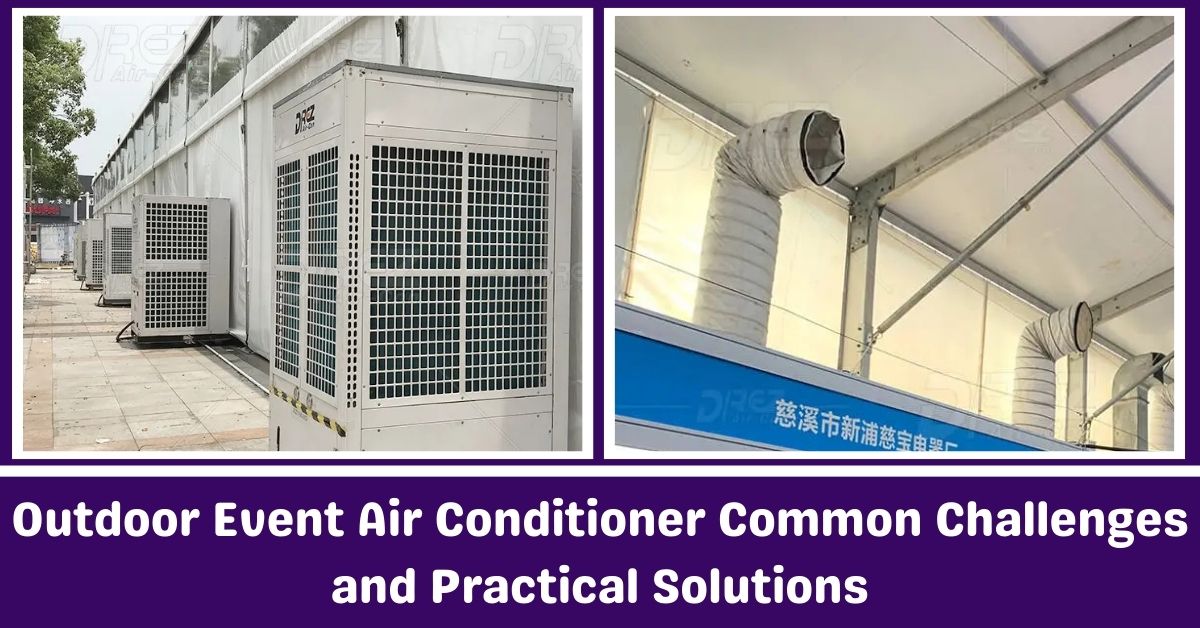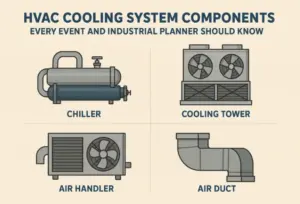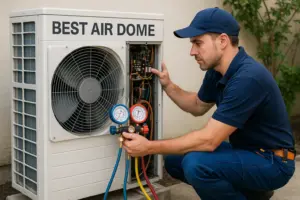Hosting an outdoor event comes with its fair share of logistical hurdles, and one of the biggest is maintaining a comfortable temperature for attendees especially in hot or humid climates.
Whether it’s a wedding, corporate gathering, concert, or trade show, temperature control can make or break the guest experience. That’s where outdoor event air conditioners come in.
These units are designed to cool open-air or tented spaces efficiently, but they often face unique environmental and operational challenges that differ significantly from indoor systems.
From power supply issues and airflow restrictions to unpredictable weather and installation limitations, event planners and technicians frequently run into obstacles that impact the effectiveness of outdoor cooling systems.
The good news? Most of these issues can be prevented or quickly resolved with the right planning, equipment selection, and site management.
Outdoor Event Air Conditioner Common Challenges and Practical Solutions
In this guide, we will explain the most common challenges associated with Outdoor Event Air Conditioners and provide practical, experience-backed solutions that can help you deliver a cooler, more comfortable experience every time.

1. Inconsistent Cooling Due to Open Air Exposure
One of the most common issues with outdoor event air conditioning is inconsistent cooling performance caused by open-air exposure.
Unlike indoor environments, outdoor spaces are not enclosed, making it difficult to retain cooled air. Even with tented setups, hot air can seep in from openings, and cooled air escapes easily.
Solution: To reduce this issue, always use air-conditioned tents with insulated walls and tight seals. Avoid standard canopy-style tents as they offer no insulation.
Use door flaps or zippered entrances to limit hot air intrusion. Place units strategically, ensuring cold air is directed into populated zones.
Using high-capacity units matched to the square footage and guest count can prevent underperformance. Also, consider placing barriers such as sidewalls or temporary enclosures to minimize airflow loss.
2. Power Supply Limitations
Outdoor venues often lack sufficient access to stable electrical power, and high-capacity air conditioners require a steady power source to function effectively.
Running multiple cooling units, lighting systems, and audio equipment can overwhelm the supply, leading to system failure or underperformance.
Solution: Conduct a full power load assessment during the planning stage. Know the wattage or amperage of every piece of equipment, including the air conditioning units.
If the existing power grid cannot support it, rent industrial generators with the proper voltage and capacity. Use separate circuits for cooling units to avoid tripping breakers.
Always include backup generators or battery systems to ensure uninterrupted service, especially for long events or those held in remote areas.
3. Noise from Air Conditioning Units
Portable and industrial outdoor air conditioners often generate high noise levels due to their powerful fans and compressors. This can interfere with audio systems, live performances, or general guest comfort, especially in quiet or formal settings.
Solution: Position the units at a distance from high-traffic or sound-sensitive areas. Use flexible ducting to channel cold air into the desired zones while keeping the equipment further away.
Some providers offer “low-noise” models designed specifically for events prioritize these when noise is a concern.
You can also build temporary acoustic barriers or place the units behind structures to absorb or block sound. Always test equipment during setup to measure noise impact in real conditions.
4. Uneven Cooling Distribution
Many events report that some areas are too cold while others remain warm, especially in large tents or multi-zone layouts.
Uneven cooling distribution usually occurs when airflow is not managed properly or when units are not evenly spaced.
Solution: Plan your layout to distribute cooling capacity evenly. Use multiple smaller units rather than one or two large ones to maintain even temperature zones.
Install additional ducting, air diffusers, or fans to push cold air into dead zones. Avoid placing cooling units in corners or behind obstructions where airflow is restricted.
During the event, regularly check and adjust airflow as guest distribution changes throughout the venue.
5. Condensation and Water Leakage
Air conditioning units naturally generate condensation, and without proper drainage, this moisture can accumulate around the units or inside tents. Leaking water can damage flooring, electronics, and create slipping hazards.
Solution: Always ensure the air conditioning units have a built-in or external drainage system. Use condensate pumps or gravity-fed hoses to direct water away from event areas.
Place units on raised platforms or waterproof mats to prevent floor damage. For tented environments, verify that ground surfaces are slightly graded or covered with waterproof flooring to guide water away from guests and equipment.
Inspect all drainage components during setup to confirm proper function.
6. Delays in Setup and Tear Down
Setting up large air conditioning units, ducting systems, and power connections takes significant time and coordination. Late delivery, site access issues, or poor planning can delay the entire event preparation process.
Solution: Schedule equipment delivery well in advance ideally 24 hours before the event. Conduct a site inspection ahead of time with your HVAC provider to identify obstacles like narrow paths, soft ground, or vehicle restrictions.
Prepare a detailed layout plan that includes unit placement, duct routing, and power connection points.
Assign technicians or site coordinators who can oversee both installation and breakdown to prevent bottlenecks. Allocate at least 2–4 hours solely for cooling system setup in your event timeline.
7. Weather Unpredictability
Outdoor events are always at the mercy of the weather. High humidity, wind, or sudden rain can drastically affect the performance of air conditioning units and overall cooling comfort.
Wind can carry away cooled air, while rain can threaten electrical safety or flood low-lying equipment areas.
Solution: Monitor weather forecasts closely in the days leading up to the event and prepare for multiple conditions. Use tents with enclosed sides and rain flaps to protect equipment and retain cooled air.
Position units in elevated or well-drained areas to avoid water exposure. Choose weatherproof or rated outdoor AC units when available.
Keep protective coverings, tarps, and emergency drainage tools on standby. Always secure ducting and cables to prevent wind displacement.
8. High Rental and Operating Costs
Outdoor event air conditioning is not cheap. Costs can increase quickly due to the need for high-capacity equipment, power generation, ducting accessories, and technician labor.
Operating costs such as fuel for generators and longer runtime also add up, especially for multi-day events.
Solution: Start by getting multiple quotes from reliable providers and ask for complete package pricing including delivery, setup, fuel, and support.
Choose energy-efficient models that can cool the space without overconsumption. Plan for only essential cooling zones there’s no need to cool areas with little or no foot traffic.
Use programmable thermostats or timers to reduce runtime. Finally, work with experienced HVAC providers who can right-size equipment to avoid over-specification, which leads to unnecessary costs.
Conclusion
Outdoor event air conditioning presents a unique set of challenges that differ significantly from indoor cooling.
Factors like open-air exposure, limited power access, equipment noise, uneven airflow, condensation, and weather unpredictability can all impact the comfort and experience of attendees.
These issues are common across various event types from weddings to trade shows and can lead to guest dissatisfaction, safety hazards, or even equipment failure if not properly managed.
However, most of these challenges are avoidable with proper planning, the right equipment, and collaboration with experienced HVAC providers.
By conducting a thorough site assessment, ensuring adequate power supply, choosing appropriately sized cooling units, and preparing for weather variations, event organizers can create a comfortable and controlled environment regardless of outdoor conditions.
Cost is always a consideration, but efficient layout design, strategic equipment placement, and energy-saving practices can keep expenses in check while maintaining performance.
In short, successful outdoor event cooling requires proactive coordination not guesswork.
By understanding the potential issues and applying the practical solutions outlined in this guide, event planners can ensure a reliable, efficient, and comfortable climate experience for guests at any outdoor venue.




